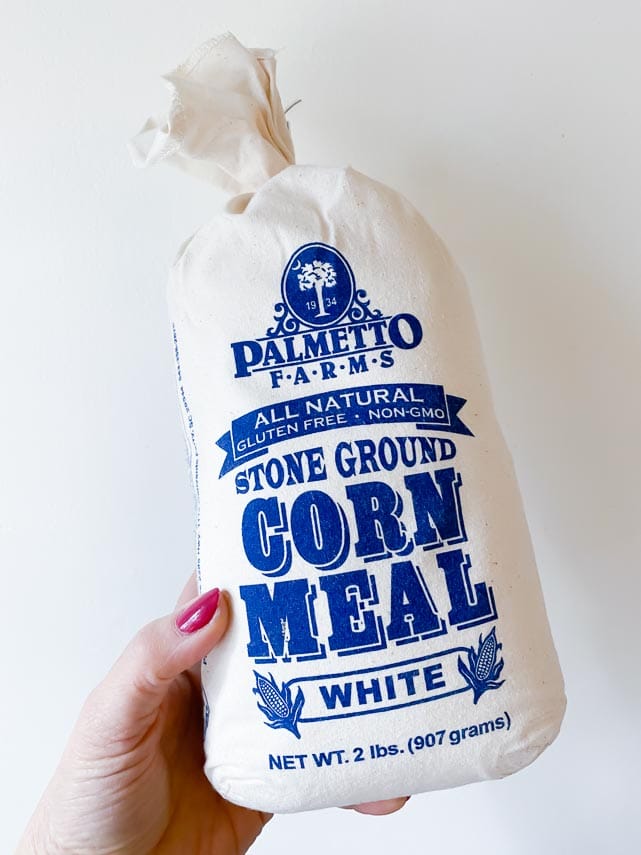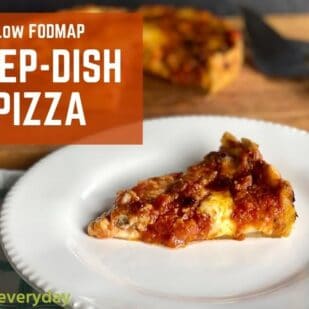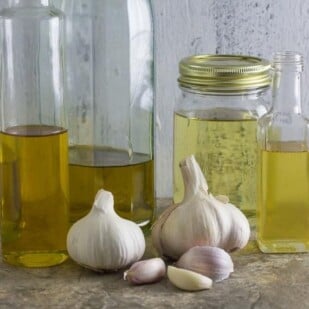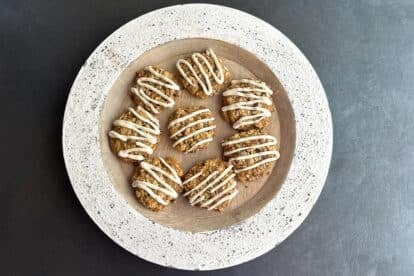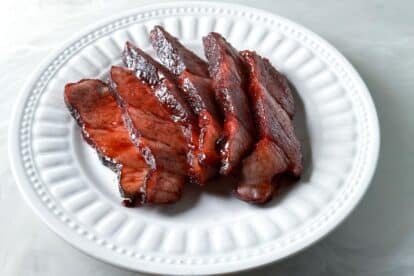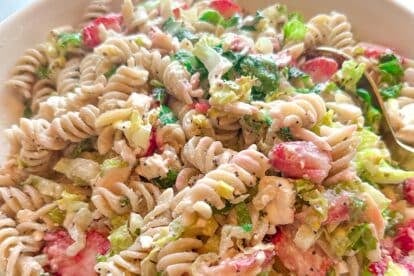Low FODMAP Grilled Pizza is gluten-free pizza made right on the grill. It is thin crusted, develops a nice char on the bottom and top (more on that later) and features varied, yet sparse, toppings. This is all about the grilled crust. For more pizza info, please read our article, Everything You Need To Know About Low FODMAP Pizza, which will link you to all of our fantastic pizza recipes: doughs, sauces and more. For a deeper dive into equipment and ingredients, please read Low FODMAP Pizza Equipment & Ingredients.
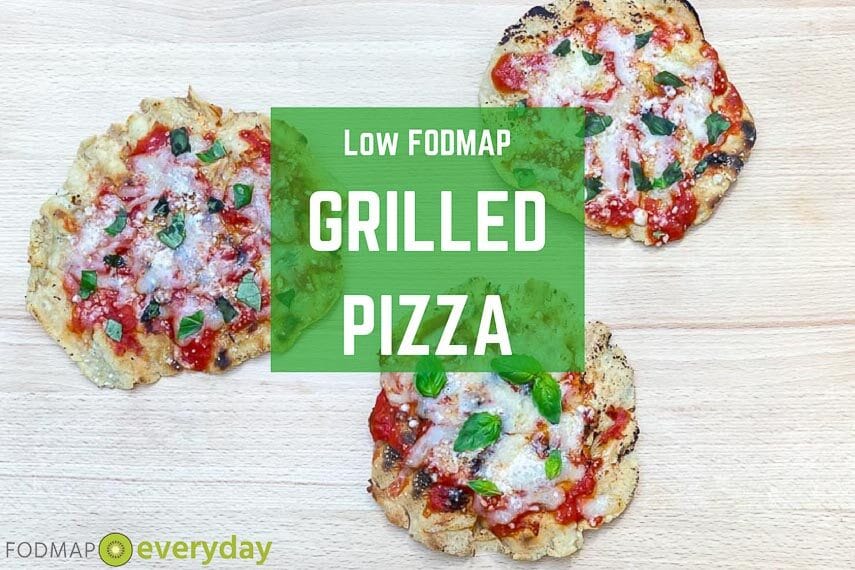
What Is Grilled Pizza?
Grilled pizza is pizza that is cooked directly on the grates of a grill, preferably charcoal or hardwood fired. You can use propane, but you will lose out on the ultimate smoky flavors.
Where Did Grilled Pizza Originate?
Johanne Killeen and George Germon (RIP) were the original owners of Al Forno restaurant in Providence, RI and developed their recipe for grilled pizza in the 1980s. I was fortunate enough to be able to work with George side by side and learn his craft. He and Joanne were trying to replicate the taste and texture of the beloved wood-fired pizzas that they had experienced in Italy. They came up with the grilled pizza technique explained in this recipe.
Most “grilled pizza” recipes online are nothing like this original approach. I see thick, sturdy pizzas cooked on a grill, or on a pizza stone set on the grill grates. Those are not what this is. This is the real deal.
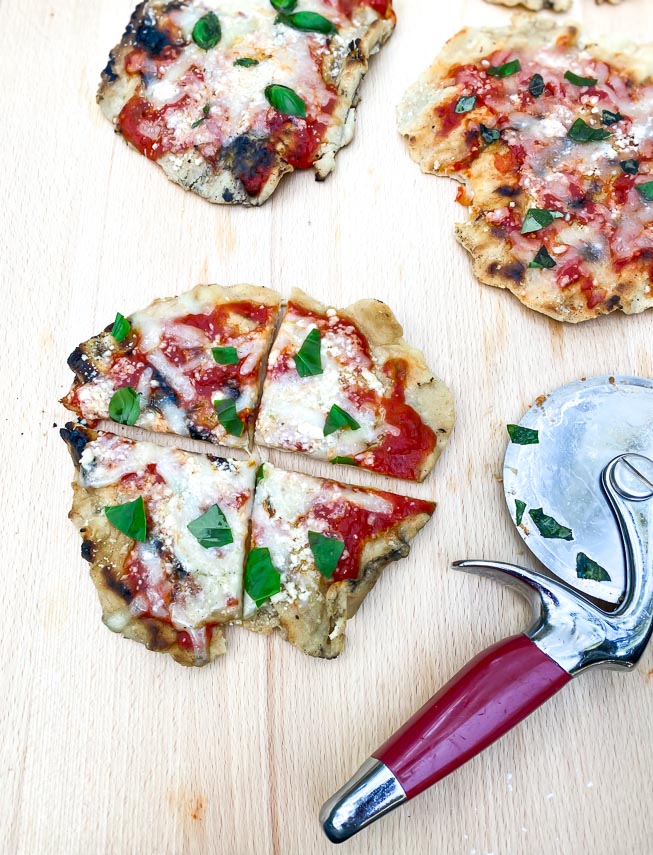
What Does Grilled Pizza Taste Like?
Grilled pizza will have a sense of fire and smoke; there should be char marks and a smoky flavor to the dough, a generous amount of olive oil used and spare toppings. It is chewy and crisp. Let the dough and grilling process shine.
Every time I would eat one of George’s pizzas, I was reminded that he applied topping very sparingly – and that is the best way to experience this dish. The pizzas could range from Margarita (their spelling) to Fresh Herbs & Tomato, to Prosciutto, Egg & Parmesan, or Red Pepper Purée & Spicy Pepper Oil, but they all had a light hand in common. I recommend the same.
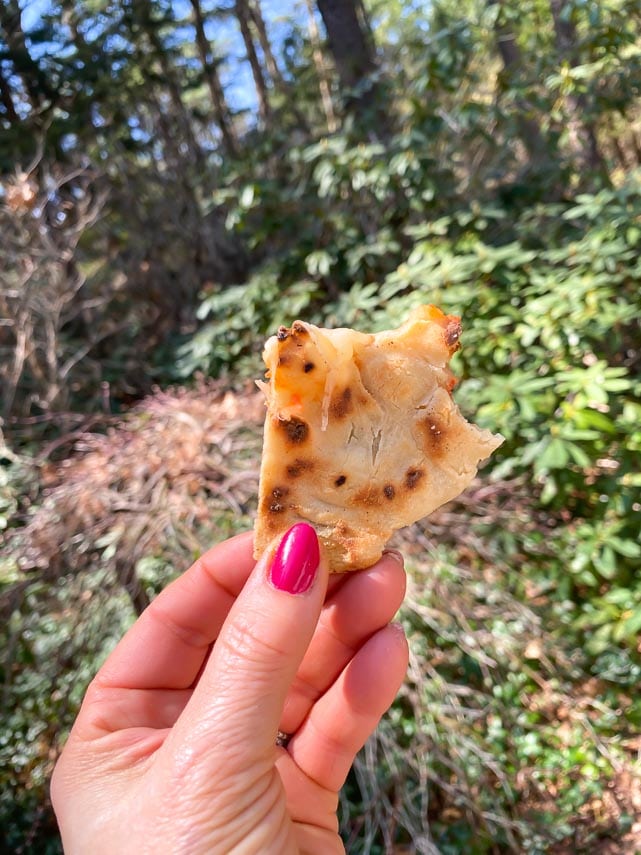
The original Al Forno grilled pizza dough recipe can be found in George and Joanne’s book, Cucina Simpatica. It was not gluten-free. It combined unbleached white flour, whole wheat flour and fine ground white cornmeal, so I have continued their tradition with some cornmeal in this low FODMAP, gluten-free version.
You probably think of mozzarella when it comes to pizza and many of our pizzas call for it. But for our grilled pizza, I follow George’s lead and use Italian Fontina and Pecorino Romano. Listen to George.
You can also learn more about cheeses in our article, Is Cheese Low FODMAP? I teach you how to tell if any cheese is low FODMAP!
Sure, you could grill any pizza dough, but you won’t get the same results as you see here. I have seen recipes that suggest a very thick, sturdy dough, which is easier to maneuver on grill grates. That is pretty much the opposite of what we have here, which is a thin, delicate dough, that is simultaneously chewy and crisp. It takes work, but it is worth it.
You can, but you will not get the same depth of flavor that you will when using a charcoal or hardwood fire. Also, the fires do not get hot enough and the pizza’s texture will not be as good.
It is not easy, and there is a learning curve. And, you have to be able to be swift on your feet, but once you get the hang of it, you will be turning out incredible pizzas and have a great sense of accomplishment.
To quote George: “Do not be timid about the preparation of this pizza. From start to finish the bold act will reward you with first-rate pizza”. And heed this quote as well: “Use a judicious hand (with toppings), and suppress the natural tendency to cover the entire surface of the dough”.
Side story: Many years ago, my ex-husband had gotten a new job and we were invited to a potluck cookout at one of his new coworker’s homes. Now, you have to understand that both he and I are major foodies and we wanted to impress. I made the dough, prepped the toppings and he loaded the kettle grill and coal up into the truck and off we went to the party. We set ourselves up and started turning out grilled pizzas. I don’t think anyone knew what hit them. Folks went from, “who are these crazy people” to “O.M.G I have never tasted anything so good” in a flash!
Every single time I have made these, people go crazy. It is worth the time spent learning the drill. Study the techniques described below before starting.
I tried really hard to make this low FODMAP, gluten-free version as close to the original as possible. It is close, but it is not the same in ingredients or technique.
One of the signature techniques for the original was to pat the dough out in olive oil, pick it up with your fingers, and lay the dough down on the grill grates. I tried several gluten-free doughs, and this just doesn’t work (even dough using the pectin-rich Better Batter). The gluten-free dough, lacking the elastic gluten network, just won’t cooperate in this vein.
For this version you pat the dough out on a floured board – or use a sheet pan like I do – and the dough here is thicker than the original, and the pizzas are also smaller in diameter. All in the name of making these do-able. There was no way that I found to make the pizzas larger, thinner and still be gluten-free and low FODMAP.
Grill Set-Up For Grilled Pizza
The most important thing when making grilled pizza when it comes to your grill itself is that you need two zones: hot and cool. This is because you will be dragging the crust from one area to the other and you need distinct zones. All the other items are necessary as well – the tables, tongs, other equipment, etc. Set yourself up for success! Once you start cooking you cannot leave the grill to run into the kitchen to gather things. This is a very hands-on process.
For Charcoal
Make a hot fire using hardwood charcoal with the coals piled up on one side of the grill. Ultimately the grill should be about 3 to 4-inches (7.5 cm to 10 cm) above the coals. When the coals have all turned ashen, you are ready to go. The fire should be hot, hot, hot.
For Propane
For propane, simply preheat your burners to high on one side, and leave off on the other.
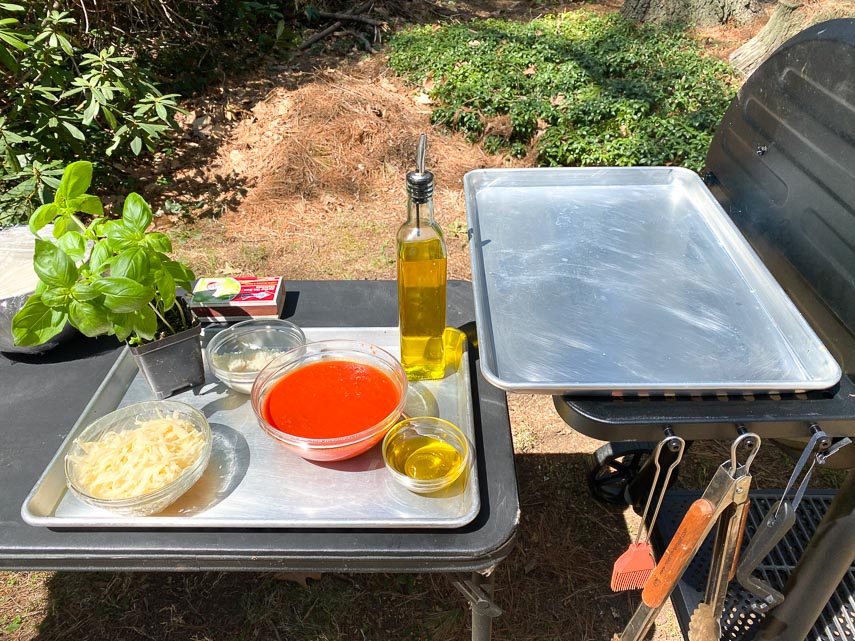
For Both Charcoal & Propane
Have a worktable to the side of grill with your set up as follows: your dough; clean sheet pan sprinkled with low FODMAP gluten-free flour; tomato sauce in a bowl with a spoon; shredded fontina in a bowl; grated Pecorino Romano in a bowl; Low FODMAP Garlic-Infused Oil in a bowl with a pastry brush; tongs; hot mitts; paper towels and/or cleaning cloths; cutting board; pizza cutter; serving platter.
Can I Make Grilled Pizza On A Small Grill?
You can even make them on a tiny hibachi! You just have to make your dough rounds smaller to fit, so that you can move them from the hot side of the grill to the cool side. Adjust serving sizes using information below as a guide.
How To Make Real Grilled Pizza
This recipe has two components: an easy sauce and the dough.
To make the dough first place all the dry ingredients in your mixing bowl.
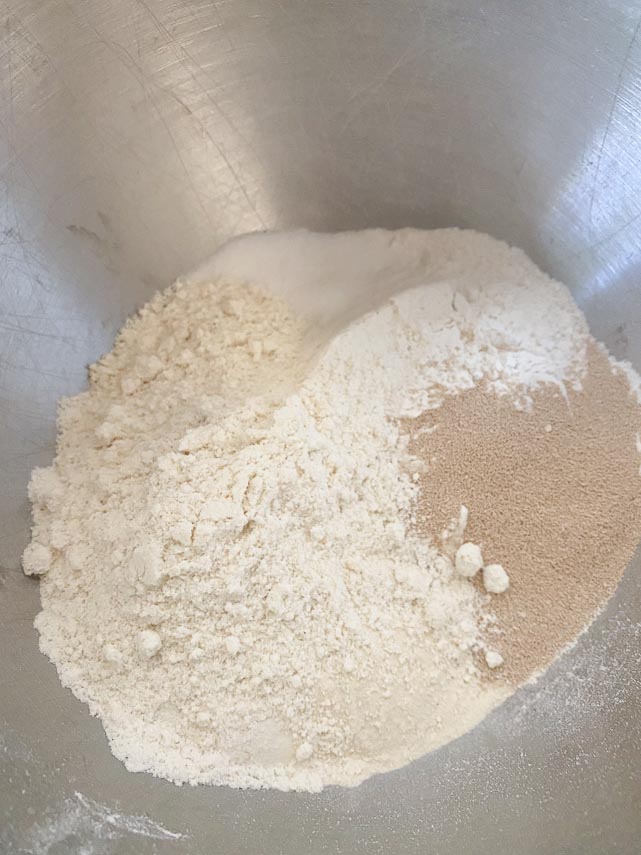
After these dry ingredients are mixed together, your warm water and olive oil are added and the dough is mixed until it is well-combined and a bit spongy. It will be moist but not sticky.
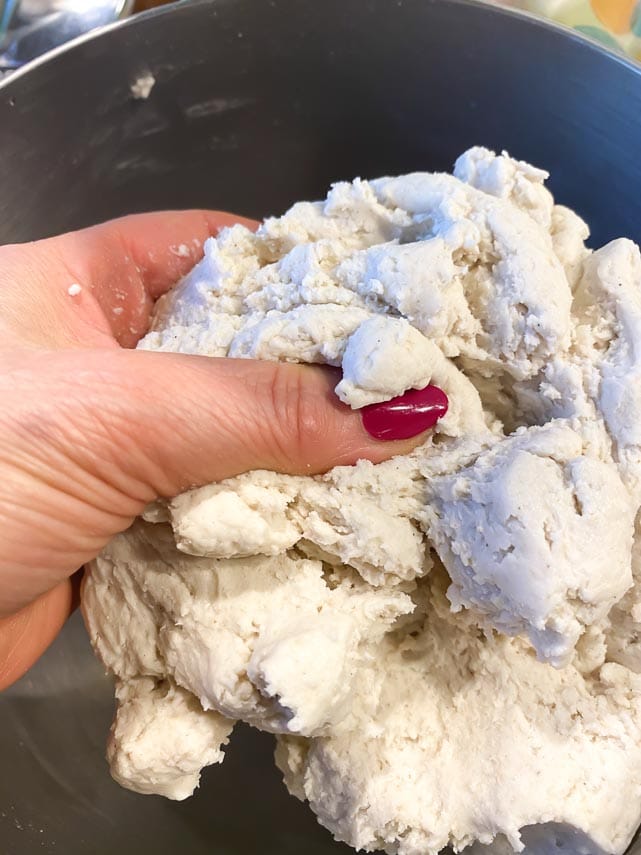
Once your dough is made and rested and has risen (and that part is fairly straightforward) you have to form the pizzas. This is where grilled pizza is very different. You will have your fire and work set-up organized as described above. Then, you take a small ball of dough and place it on the floured pan. Press the dough out to a thin, even thickness using floured fingers and palms. You want to make it as thin as you can and still be able to pick it up without it falling apart.
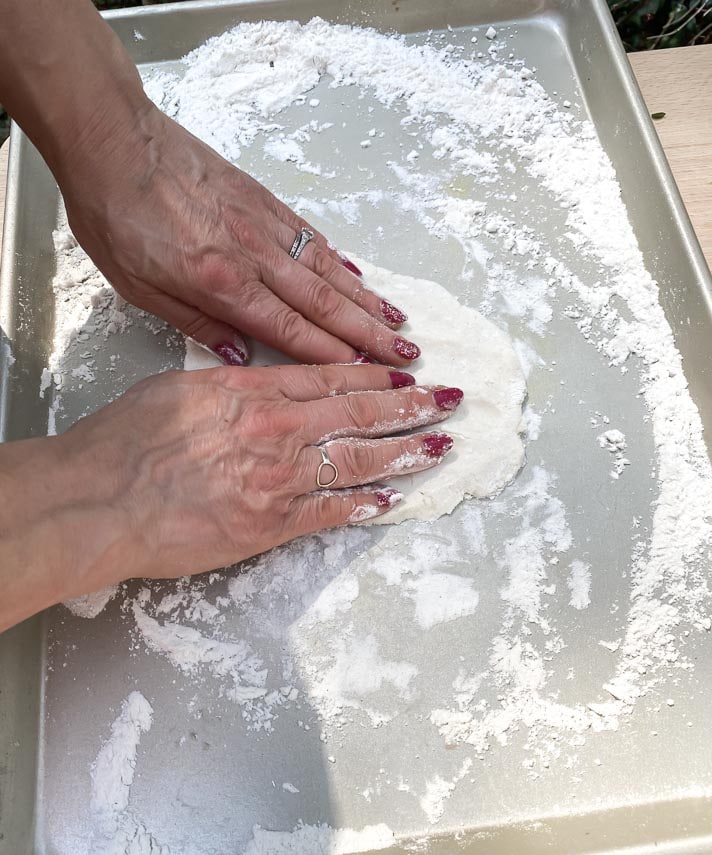
About 6 to 7-inches (15 cm to 17 cm) across is a good diameter. Go for a rounded shape, but it is perfectly fine if it is vaguely amoeba-like or even rectangular. The thinness is far more important than shape. Do not create a thicker rim.
Pick the dough up with two hands and/or a broad metal spatula and swiftly but carefully transfer it to the hot side of the grill.
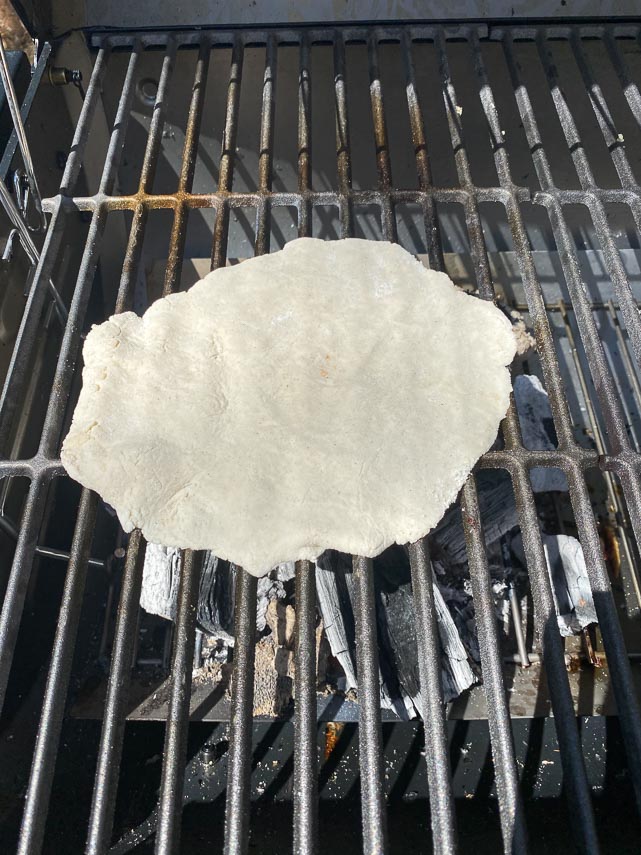
Brush the top of the crust with Low FODMAP Garlic-Infused Oil. It must be made with olive oil.
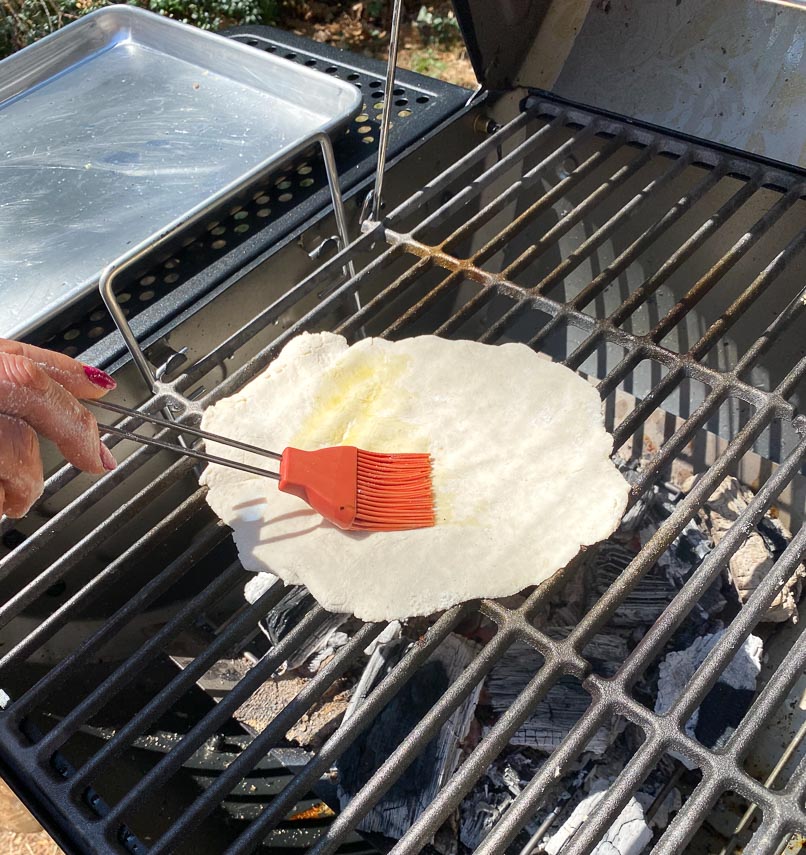
Within a minute or so the crust will puff up and charred grill marks will appear on the bottom of the crust.
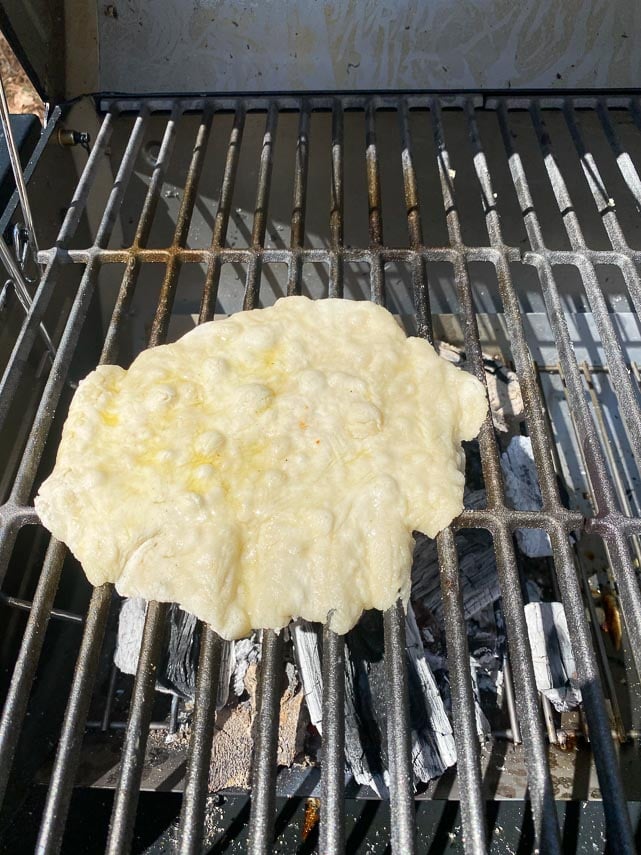
Flip the crust over with your tongs and drag it over to the cool side of the grill. Brush the crust with more garlic-infused olive oil.
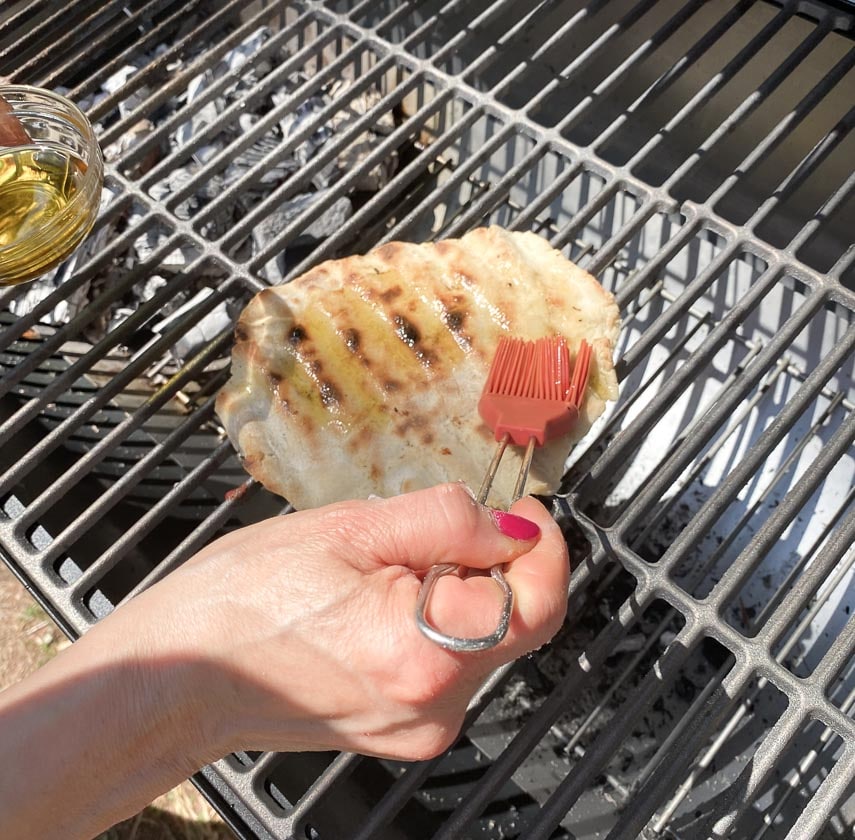
Sparingly dollop tomato sauce here and there.
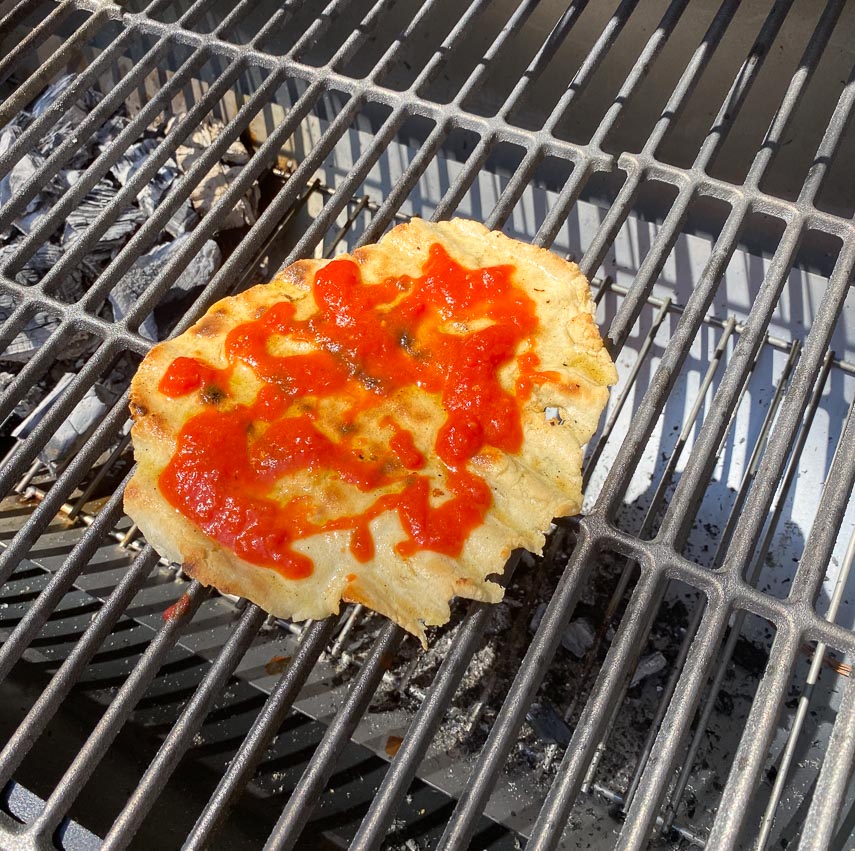
Then lightly scatter Fontina cheese over the sauce…
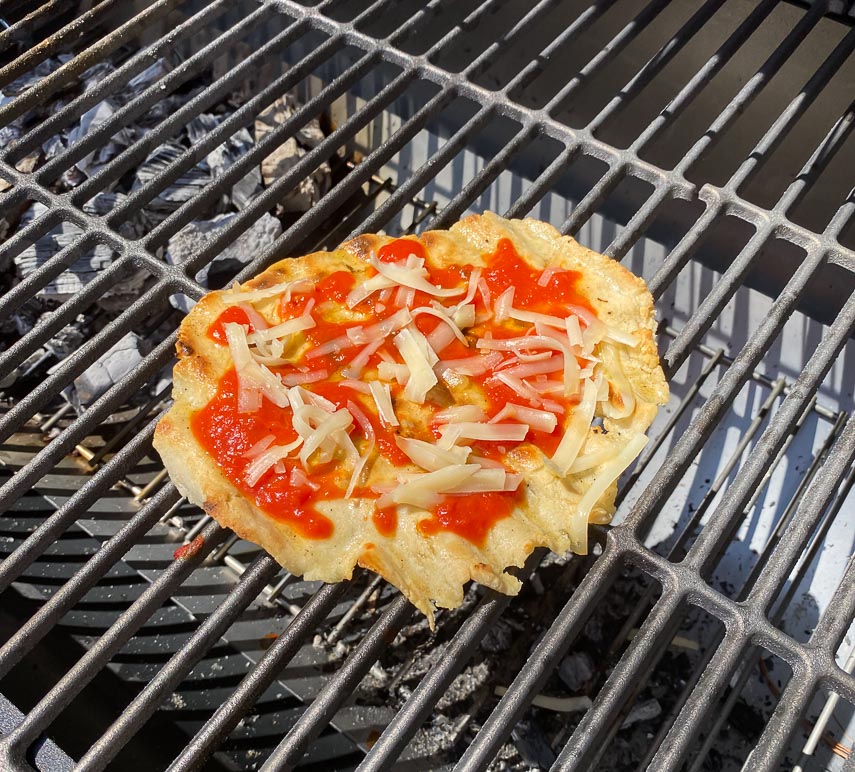
Then add a light sprinkling of Romano. Do not try to cover the whole surface with tomato sauce and cheese.
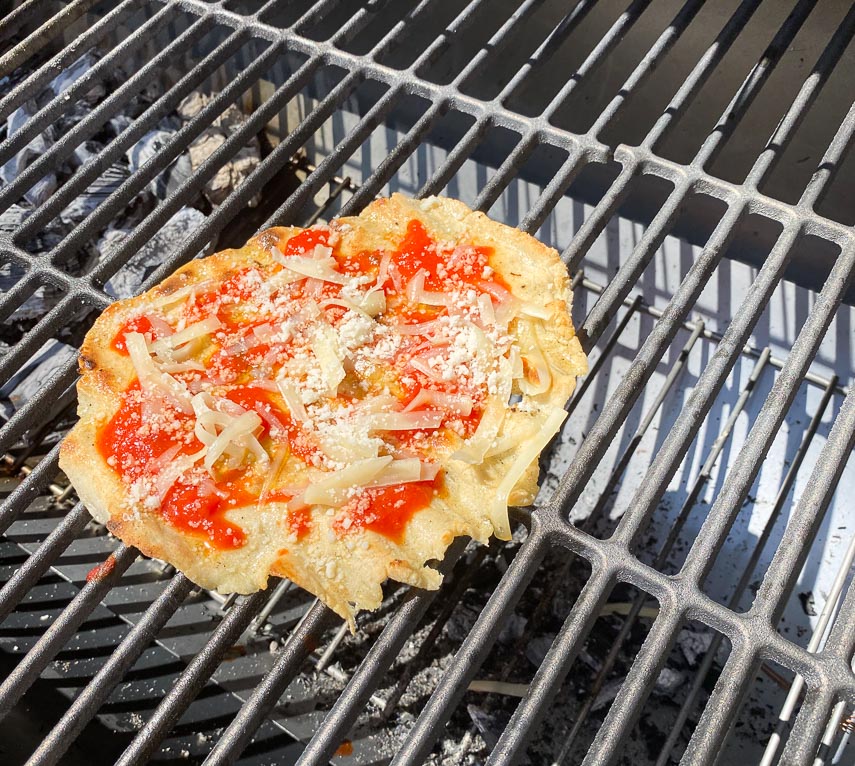
Use tongs to drag crust back over to the hot side.
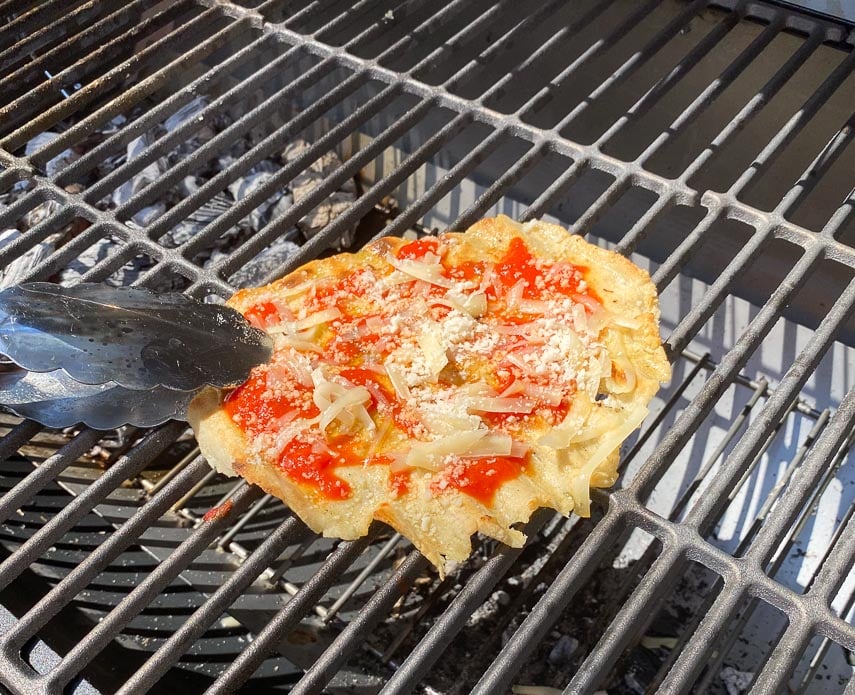
Use tongs to rotate the crust over the hot coals and monitor it closely. You want the cheese to melt and the bottom to develop nice char marks without burning. This part will take maybe 3 to 5 minutes, but you cannot walk away! Once done, use tongs again to drag pizza onto your cutting board, scatter fresh basil leaves on top (torn or whole), and have someone start serving immediately while you get to work on the other pizzas. These pizzas wait for No One!
Once you get the hang of it, you can have more than one pizza going at a time.
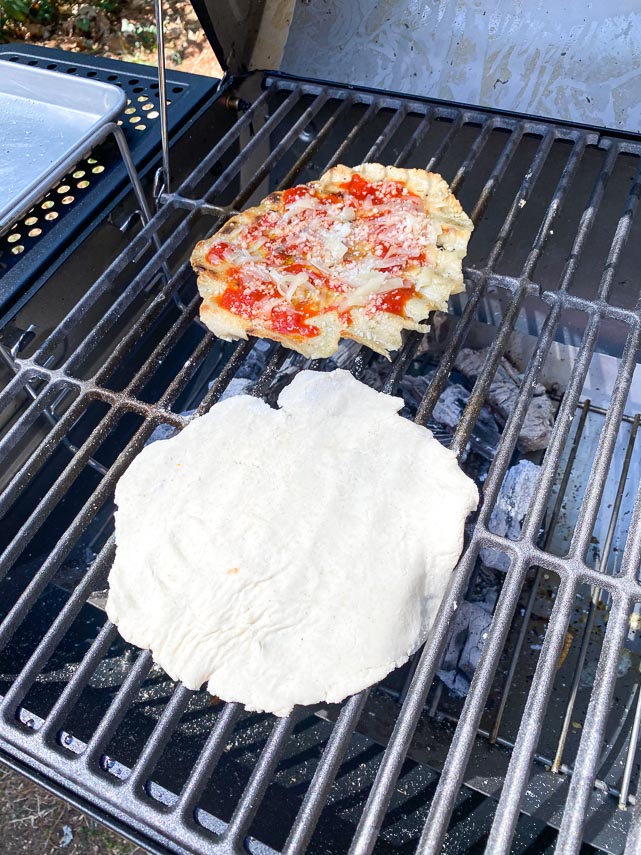
More Gluten-Free Pizza Recipes
Not all of our pizza recipes are gluten-free, but several, in addition to this one, are. Here is our list of Gluten-Free Pizza Recipes.
- Low FODMAP Easy Pizza
- Low FODMAP Pizza 2.0
- Caputo Fioreglut Low FODMAP Pizza
- Low FODMAP Deep-Dish Pizza
- And this one, our Low FODMAP Grilled Pizza
FODMAP Information
Our recipes are based on Monash University and FODMAP Friendly science.
- Canned Tomatoes: Monash University has lab tested canned tomatoes and they are low FODMAP at 92 g or 3.2-ounces, which they say is about ⅗ of a cup. Moderate FODMAPs kick in at about ¾ cup or 115 g, at which point fructose can become an issue.
- Cheese: Many cheeses have low FODMAP serving sizes. The low FODMAP diet is not a dairy-free diet. Hard cheeses such as Parmigiano Reggiano or Pecorino Romano have been lab tested by Monash University and are low FODMAP in 40 g amounts.
- Oil: All pure oils are fats and contain no carbohydrates, therefore they contain no FODMAPs.
- Sugar: Monash University and FODMAP Friendly have both lab tested white, granulated sugar. Monash states that a Green Light low FODMAP serving size of white sugar is ¼ cup (50 g). FODMAP Friendly simply states that they have tested 1 tablespoon and that it is low FODMAP. Regular granulated white sugar is sucrose, which is a disaccharide made up of equal parts glucoseand fructose. Sucrose is broken down and absorbed efficiently in the small intestine.
- Tomatoes: Both Monash University and FODMAP Friendly have lab tested common, beefsteak tomatoes. Monash University lab tests have shown no FODMAPs. FODMAP Friendly gives them a “Pass” at ½ cup (75 g) portions. Cherry tomatoes and Plum (Roma) tomatoes have also been tested by Monash and FODMAP Friendly. Both Monash and FODMAP Friendly recommend 75 g of cherry tomatoes as a serving (about 5 or ½ cup) and 75 g of plum or Roma tomatoes, which is about 1 small tomato or ½ cup.
- Yeast: Yeast – fresh, dry and instant – are all low FODMAP.
Please always refer to the Monash University & FODMAP Friendly smartphone apps for the most up-to-date lab tested information. As always, your tolerance is what counts; please eat accordingly. The ultimate goal of the low FODMAP diet is to eat as broadly as possible, without triggering symptoms, for the healthiest microbiome.
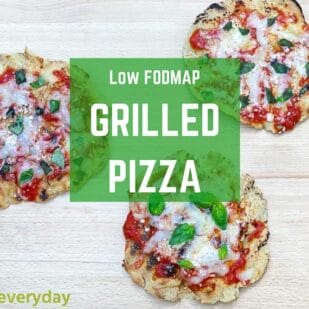
Low FODMAP Grilled Pizza
Low FODMAP Grilled Pizza is gluten-free pizza made right on the grill. It is thin crusted, develops a nice char on the bottom and top (more on that later) and features varied, yet sparse, toppings. This is all about the grilled crust. For more pizza info, please read our article, Everything You Need To Know About Low FODMAP Pizza, which will link you to all of our fantastic pizza recipes: doughs, sauces and more.
Low FODMAP Serving Size Info: Makes about 10, 6-inch (15 cm) pizzas; 10 servings; 1 pizza per servings
Ingredients:
Grilled Pizza Sauce:
- 1, 28- ounce (794 g) can of either whole peeled tomatoes in juice or purée, or puréed/crushed tomatoes
- ½ teaspoon FreeFod Garlic Replacer
- ½ teaspoon kosher salt
- 1 tablespoon extra-virgin olive oil
Grilled Pizza Dough:
- 2 ½ cups (363 g) low FODMAP gluten-free all-purpose flour, such as Bob’s Red Mill 1 to 1 Gluten Free Baking Flour, plus extra
- ¼ cup (25 g) fine-ground white cornmeal
- 1 tablespoon instant dry yeast
- 1 ½ teaspoons salt
- 1 teaspoon xanthan gum
- Pinch sugar
- 1 cup (240 ml) plus 3 tablespoons warm water, 120°F to 125°F (48°C to 52°C)
- 1 tablespoon extra-virgin olive oil
Toppings:
- 7- ounces (200 g) shredded Italian Fontina (about 2 cups)
- ½ cup (50 g) ground Pecorino Romano
- Low FODMAP Garlic-Infused Oil, made with olive oil
- Fresh basil or other herbs
Preparation:
-
Make The Sauce: If using whole canned tomatoes, put them through a food mill or pulse very briefly in blender just enough to break down. Take that tomato mixture, or the canned puréed/crushed tomatoes and pour into a pot. Whisk in the teaspoon FreeFod Garlic Replacer and salt until combined, then whisk in the oil. Bring to a simmer over low-medium heat and simmer, stirring often, until slightly thickened, about 5 minutes. Cool. Sauce made be made 3 days ahead and refrigerated in an airtight container.
-
For Making Dough By Hand: Whisk together the flour, cornmeal, yeast, salt, xanthan gum and sugar in a large bowl to aerate and combine. Add the warm water and olive oil and begin to stir together with a sturdy wooden spoon until a wet dough forms, then beat vigorously until mixture looks like a thick, moist batter.
-
For Making Dough With A Stand Mixer: Place the flour, cornmeal, yeast, salt, xanthan gum and sugar in stand mixer bowl fitted with flat paddle attachment and mix on low to aerate and combine. Add the warm water and olive oil and mix on low-medium speed until a wet dough forms, then turn speed up to medium to medium-high and beat until mixture looks like a thick, moist batter.
-
Lightly coat a bowl or container with olive oil, scrape the dough into the receptacle and turn the dough around to coat with oil. Seal the bowl with plastic wrap, or snap on a cover to the container and place in a warm, draft-free area for 2 hours or until it has visibly risen. Punch down, cover, and allow to rise for another 45 minutes to an hour. Prep your toppings and get your grill ready at this time.
-
Make a hot fire using hardwood charcoal with the coals piled up on one side of the grill. Ultimately the grill should be about 3 to 4-inches (7.5 cm to 10 cm) above the coals. When the coals have all turned ashen, you are ready to go.
-
Take a small ball of dough and place it on a floured half-sheet pan. Press the dough out to a thin, even thickness using floured fingers and palms. You want to make it as thin as you can and still be able to pick it up without it falling apart. About 6 to 7-inches (15 cm to 17 cm) across is a good diameter. Go for a rounded shape, but it is perfectly fine if it is vaguely amoeba-like. The thinness is far more important than shape. Do not create a thicker rim.
-
Pick the dough up with two hands and/or a broad metal spatula and swiftly but carefully transfer it to the hot side of the grill. Brush the top with Low FODMAP Garlic-Infused Oil. Within a minute or so the crust will puff up and charred grill marks will appear on the bottom of the crust. Flip the crust over with your tongs and drag it over to the cool side of the grill. Brush the crust with more garlic-infused olive oil.
-
Sparingly dollop tomato sauce here and there, then lightly scatter Fontina cheese over the sauce, then add a light sprinkling of Romano. Do not try to cover the whole surface with tomato sauce and cheese. Use tongs to drag crust back over to the hot side. Use tongs to rotate the crust over the hot coals and monitor it closely. You want the cheese to melt and the bottom to develop nice char marks without burning. This part will take maybe 3 to 5 minutes, but you cannot walk away! Once done, use tongs again to drag pizza onto your cutting board, scatter fresh basil leaves on top (torn or whole), and have someone start serving immediately while you get to work on the other pizzas. These pizzas wait for No One!
-
It is possible to do two or three pizzas at a time on larger grills, all at staggered stages, but this takes practice.
Notes:
FODMAP Information
Our recipes are based on Monash University and FODMAP Friendly science.
• Canned Tomatoes: Monash University has lab tested canned tomatoes and they are low FODMAP at 92 g or 3.2-ounces, which they say is about ⅗ of a cup. Moderate FODMAPs kick in at about ¾ cup or 115 g, at which point fructose can become an issue.
• Cheese: Many cheeses have low FODMAP serving sizes. The low FODMAP diet is not a dairy-free diet. Hard cheeses such as Parmigiano Reggiano or Pecorino Romano have been lab tested by Monash University and are low FODMAP in 40 g amounts.
• Garlic-Infused Oil: Make your own Garlic-Infused Oil or buy a commercial equivalent for the easiest way to add garlic flavor to your food. Fructans in garlic are not oil-soluble, so garlic-infused oil is low FODMAP.
• Oil: All pure oils are fats and contain no carbohydrates, therefore they contain no FODMAPs.
• Sugar: Monash University and FODMAP Friendly have both lab tested white, granulated sugar. Monash states that a Green Light low FODMAP serving size of white sugar is ¼ cup (50 g). FODMAP Friendly simply states that they have tested 1 tablespoon and that it is low FODMAP. Regular granulated white sugar is sucrose, which is a disaccharide made up of equal parts glucose and fructose. Sucrose is broken down and absorbed efficiently in the small intestine.
• Tomatoes: Both Monash University and FODMAP Friendly have lab tested common, beefsteak tomatoes. Monash University lab tests have shown no FODMAPs. FODMAP Friendly gives them a “Pass” at ½ cup (75 g) portions. Cherry tomatoes and Plum (Roma) tomatoes have also been tested by Monash and FODMAP Friendly. Both Monash and FODMAP Friendly recommend 75 g of cherry tomatoes as a serving (about 5 or ½ cup) and 75 g of plum or Roma tomatoes, which is about 1 small tomato or ½ cup.
• Yeast: Yeast – fresh, dry and instant – are all low FODMAP.
Please always refer to the Monash University & FODMAP Friendly smartphone apps for the most up-to-date lab tested information. As always, your tolerance is what counts; please eat accordingly. The ultimate goal of the low FODMAP diet is to eat as broadly as possible, without triggering symptoms, for the healthiest microbiome.
Nutrition
All nutritional information is based on third-party calculations and should be considered estimates. Actual nutritional content will vary with brands used, measuring methods, portion sizes and more. For a more detailed explanation, please read our article Understanding The Nutrition Panel Within Our Recipes.
